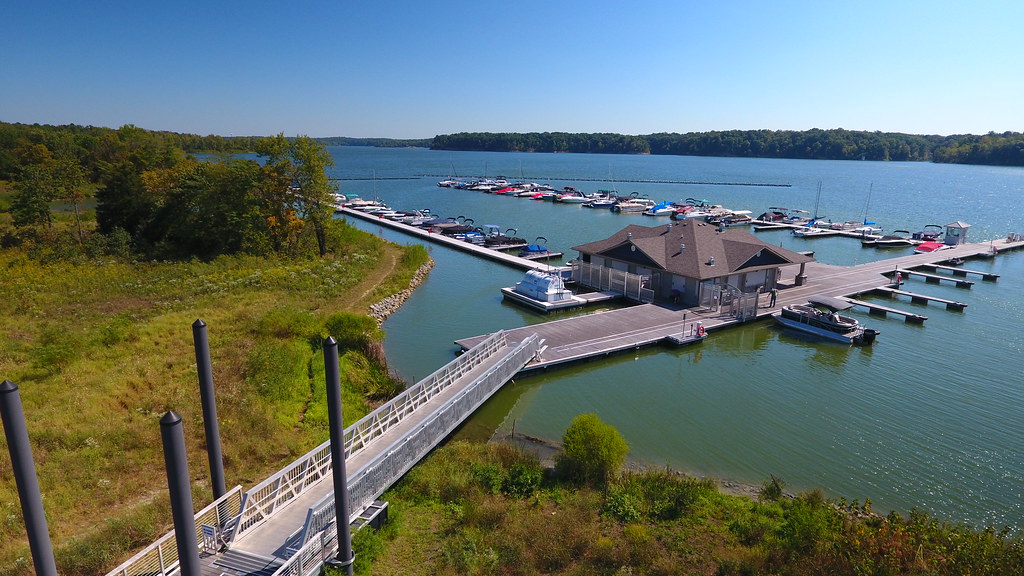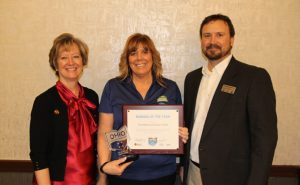
Caesar Creek Marina Awarded Ohio’s 2021 Clean Marina of the Year
Published on April 26, 2022It’s nothing but good, clean fun at The Marina at Caesar Creek, recently named Ohio’s 2021 Clean Marina of the Year. Built within Caesar Creek State Park on Caesar Creek Lake in Waynesville, Ohio in 2016 and comprised of 122 slips, the facility was recognized for its sustainable design and the daily efforts of its dedicated staff.

The title was awarded by the Ohio Clean Marinas Program, established in 2004 as a proactive partnership initiative between Ohio Sea Grant and the Ohio Department of Natural Resources (ODNR) Office of Coastal Management. Ohio’s program is part of the Great Lakes Clean Marina Network and coordinates with other state Clean Marina programs across the nation.
The program, which initially focused on marinas in the Lake Erie watershed, is now statewide. “Our main goal as a program is to provide education and technical assistance to give all Ohioans easy ways they can help protect our waterways,” said Heather Sheets, the Ohio Clean Marinas program coordinator. Sheets said The Marina at Caesar Creek went above and beyond, specifically mentioning the facility’s commitment to boater education.
Sustainable Design Initiatives
The Marina at Caesar Creek exemplifies how design considerations can benefit the continued life of the local waterways. Its living shoreline with sophisticated stormwater planning and landscaping of native plants, naturally filter water runoff before it re-enters the lake. The marina staff employ eco-conscious practices such as regular water quality tests and annual aerial surveys in search of harmful algae blooms. “We represent how everybody can balance-wise use with protecting our natural resources and being good stewards,” said Caesar Creek State Park manager, Tiffany Dechant-Hunt.
It wasn’t until 2015, with the help of the ODNR Division of Parks and Watercraft, that the Ohio Clean Marinas Program expanded its reach beyond Lake Erie to incorporate inland lakes and waterways. In 2017, they implemented a three-tiered program of Base, Gold, and Platinum certification levels. The new tiers allowed for more pathways to certification and encouraged continuous improvement of best management practices (BMPs), especially as the program now covered marinas of various sizes and clientele.
“The Lake Erie marinas are often very different than our inland marinas,” Sheets explained. “Whereas some marinas do a lot more boat maintenance, and work towards BMPs to prevent contaminants entering the waterways, some marinas do not allow boat maintenance and can now get more credit for things like boater education and community outreach. It was originally hard to compare the various types of marinas, but the tiered approach allows for site-specific requirements and recognition for things like recycling and green infrastructure, that were not on the original checklist.”
Today, the program includes 90 clean marinas statewide with 20 in Gold and 13 in Platinum standing. Caesar Creek Park became a Platinum level Clean Marina in 2019.
While a sustainable design provided a solid foundation for Caesar Creek, it’s the dedication and innovation of the staff that has made them a model marina. Educating boaters on best management practices is a regular part of the job, explained assistant park manager, Clint Tellep. “We hand out pamphlets and send emails with articles on things like electric shock drowning, the proper materials to clean the boats, and what to do in case of an oil spill or fuel spill,” he added.
Educating the public takes a knowledgeable staff and so employee training is paramount to the program’s success. “We train our staff on all of those sustainable practices,” Dechant-Hunt explained. “We use green products when we’re cleaning so we’re being good role models. We’re showing that you can do all of these sustainability items pretty easily.”
The Certification Process
Clean Marina certification is made possible by a five-step process that begins with a training workshop, then a pledge to the program. Representatives from the Ohio Clean Marina program then make a preliminary site visit and provide recommendations to the marina for best management practices. The marina then implements the recommended changes to achieve certification. There are five sections on which marinas are evaluated which include Marina Management, Water Management & Resiliency, Ecological Considerations, Boater Education, and Employee Training & Community Outreach. Within each section there are numerous items that can earn points for a marina. For example, Marina Management includes items such as cleaning up marine debris, energy efficiency practices such as solar lighting, or keeping an oil boom on-hand in case of a spill. “Water Management and Resiliency can be small things like low-flow toilets or timed faucets,” said Sheets, “to big projects like storm water filtration or using permeable pavement or walkways.” Points in the Ecological Considerations section can be earned by enhancing wetlands or creating wildlife habitat like fish spawning beds. It’s in this section that Caesar Creek Marina earned points for its naturalized shoreline however, simpler features such as “No Wake” signs to prevent waves from eroding the shore, and signage educating visitors on invasive aquatic species also generate points. In the Boater Education section, tasks can range from providing vessel safety checks to providing educational materials to clients. “A lot of our marinas like Caesar Creek put best practices in their boater slip agreements,” Sheets said. “When [boaters] make their reservation for the season they have to sign the contract which includes some mandatory environmental best management practices.”
The final section of the program is the Employee Training and Community Outreach, in which Caesar Creek benefits from its nature center with a naturalist on staff, and community programs like the life jacket loaner program. “The ultimate goal is to get all of the marinas certified and educate Ohio boaters, too,” Sheets said.
While ecological impact is a top consideration for many marina owners and members of the boating community, Sheets understands that most marinas are small businesses, without large budgets for state-of-the-art sustainability measures. However, she said that the tiered program allows for variety in achieving certification and that ultimately, the designation can be good for business. “We definitely stress it’s not just good for the environment, but can be good for marketing and increasing patrons,” Sheets added.
Certification in the program places a marina onto the Great Lakes Clean Marina Network’s website and map which provides some additional exposure in a growing market and client-base across the Great Lakes.
Ultimately, the program’s strength is in the dedication and creativity of its members, whose motivation flows from an appreciation of their local waterways. “We’re really proud of our work,” Dechant-Hunt said. “The passion also spreads to the public and the community.”
| Categories | |
| Tags |






